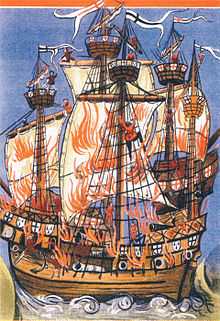Banderole

A Banderole (Fr. for a "little banner"), has both a literal descriptive meaning for its use by knights and ships, and is also heraldic device for representing bishops.
Bannerol, in its main uses is the same as banderole, and is the term especially applied to banners about a yard square carried at the funerals of great men and placed over the tomb.[1][2] Often it commemorated a particular exploit of the person bearing the coat of arms.
Knights, bishops and ships
A Banderole is a small flag or streamer carried on the lance of a knight, or a long narrow flag, with cleft end flying from the mast-head of a ship in battle.[1][2]

In heraldry, a banderole is a streamer hanging from beneath the crook of a bishop's crosier and folding over the staff,[1][2] and for other small streamers or ribbons.[3]
Art and architecture
- Main Banderole (speech scroll)

The term is also used in art and architecture for a speech scroll or streamer, representing a roll of parchment carried by or surrounding a figure or object, for bearing an inscription, mainly during the medieval and Renaissance periods.[4] In particular banderoles were used as attributes for Old Testament prophets, as may be seen in the Santa Trinita Maestà by Cimabue, (Uffizi, 1280–90), Duccio's Maestà (1308–11), and other works. The convention had a historical appropriateness, as the Old Testament was originally written on scrolls, whereas nearly all surviving New Testament manuscripts are codices (like modern books). They may also be used for the words of angels, especially Gabriel's greeting to Mary in Annunciation scenes.[5]
Late 18th, 19th, and early 20th Century military equipment
Starting in the British Army during the French-And-Indian War (1754-1763), and continuing in use in various armies throughout the later 18th, 19th, and early 20th Centuries, up to and including the Soviet Red Army in their "Great Patriotic War" (1941-1945), the term en banderole referred to soldiers wearing either their greatcoat (heavy overcoat) or blanket, rolled up along its longer edge, draped over one shoulder and across their back and breast, and fastened—sometimes with a small bespoke strap, other times with a short length of simple rope—near their waist. The practice was begun by British light infantrymen fighting in North America during the Seven Years' War, known there as the "French and Indian" war, to make carrying their equipment more convenient to fighting in the heavily wooded terrain.
Notes
- ↑ 1.0 1.1 1.2
 One or more of the preceding sentences incorporates text from a publication now in the public domain: Chisholm, Hugh, ed. (1911). "Banderole". Encyclopædia Britannica 3 (11th ed.). Cambridge University Press.
One or more of the preceding sentences incorporates text from a publication now in the public domain: Chisholm, Hugh, ed. (1911). "Banderole". Encyclopædia Britannica 3 (11th ed.). Cambridge University Press. - ↑ 2.0 2.1 2.2 OED staff 2011.
- ↑ Nelson 2010.
- ↑ Chisholm 1911.
- ↑ Ladis, Andrew & Maginnis, Hayden B. J., Painting in the Age of Giotto: A Historical Reevaluation, pp. 155-156, 1997, Penn State Press, ISBN 0-271-02091-1, ISBN 978-0-271-02091-4
References
- OED staff (September 2011). "banderol[e] | bandrol | bannerol, n.". Oxford English Dictionary (Second 1989; online version September 2011. ed.). Earlier version first published in New English Dictionary, 1885.
- Nelson, Phil (1 February 2010). "Banderole". Dictionary of heraldic terms.